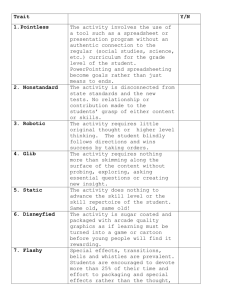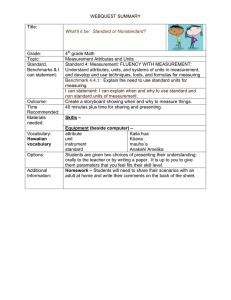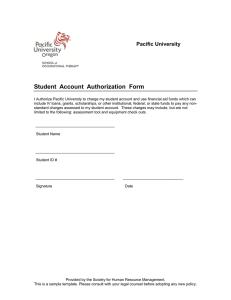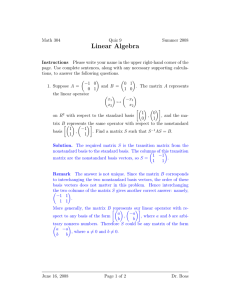Openness and the Share of Nonstandard Workers Ahn, Joyup February 4, 2011
advertisement
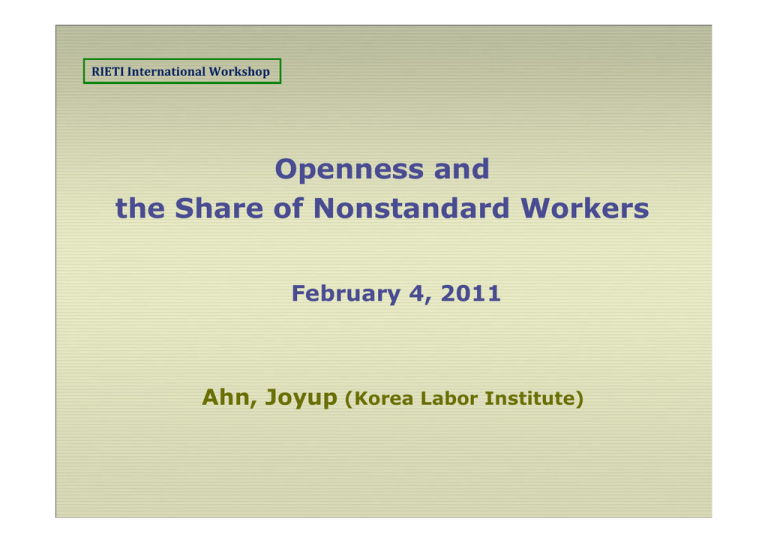
RIETI International Workshop Openness and the Share of Nonstandard Workers February 4, 2011 Ahn, Joyup (Korea Labor Institute) Contents 1. Purpose of Study 2. Definition of Nonstandard Employment 3. The Recent Trends in Nonstandard Work 4. Openness and its Share 5. Summary Workshop: Korean Development Experience 2 Purpose of Study ☞ Firms, facing with more severe competition in the process of globalization, try to maximize their profits by utilizing more nonstandard workers. ☞ Firms use nonstandard workers in order to reduce labor costs because they are paid less and are not fully covered by the social insurance system and, under the stringent employment protection legislation, to optimize employment by easing layoff them. ☎ Is such argument right? There is few empirical evidence that globalization induces more utilization of nonstandard workers ☞ This study examines whether the degree of globalization and the share of nonstandard employment have a SIGNIFICANT relationship at the industry level, ☞ Estimating a panel model by using the data from the monthly Economically Active Population Survey (EAPS) (August Supplement) over 2002~2010 and ☞ Testing the null hypothesis that globalization measures have no additional significant effect on the share of nonstandard workers after ☞ Examining the definition of nonstandard employment and the its recent trends by their various types, industries, and firm sizes. ☎ Important: it is DIFFICULT to define the measure of globalization Workshop: Korean Development Experience 3 Definition of Nonstandard Workers Work Status at a job To the respondent who is identified as “worker” by the questionnaires Q7~Q9, the questionnaire Q30 is applied to classify workers into 1 of 6 categories. Q30. What was your work status at the job? the employeed 1. permanent worker 2. temporary worker the self-employed 4. employer 5. own account worker 3. daily worker 6. unpaid family worker 1. Permanent worker 2. Temporary worker 5. Own account worker The unemployed 4. Employer Not-in-the labor force 3. Daily worker 6. Unpaid family worker Workers Nonstandard Work in Korea 4 Definition of Nonstandard Employment The Employed = Standard Employment + NonStandard Employment which is NOT nonstandard employment Nonstandard Employment = Contingent Work + Part-time Work + Alternative Employment Arrangements The employed NonStandard Employment Full-time Part-time Contingent Work Standard Employment Alternative Employment Arrangement Nonstandard Work in Korea 5 Definition of Nonstandard Employment Contingent Work Fixed-term work: the employment contract (implicit or explicit, document or oral) with a specified duration (‘Yes’ to the Questionnaire 32) Q32. Did you set a duration of work at the current job at the outset? Temporary Employment Those who work without a contract with a specified duration and ‘No’ to Q43 and 1~6 to Q45 (TE1) OR ‘Yes’ to Q43 and 2 to Q43.1 (TE2) Because the contract is kept on by its repetition or renewal Fixed-Term Employment Contract w/ a specified duration Yes No Temporary Employment Nonstandard Work in Korea TE1 TE2 No Expect to keep working Yes 6 Definition of Nonstandard Employment Contingent Work Q43. Is it possible for you to continue working at this job as far as you want UNLESS you make a serious mistake OR your company faces with closing or restructuring due to a serious difficulty in business? Q43-1. What is the reason why you say ‘Yes’, i.e., that you can continue to work? 1. Because the contract does NOT specified its duration. 2. Because the contract is kept on by its repetition or renewal. 3. Because there is a implicit practice of continuing the contract. Q45. Why do you think so? Choose the main reason. 1. The contract expires. 2. The contract would be terminated implicitly or explicitly. 3. This job started under the condition that it expires by employer’s discretion 4. The current project will end 5. This job is a temporary substitution 6. The job is for seasonal work 7. I am going to search another job due to aptitude, working condition, or ability 8. I will be old enough to retire by the general practice or provisions in the workplace 9. There will be an issue related to schooling, family affairs, or health 10. Managerial difficulties in my workplace 11. Other (_________________) Nonstandard Work in Korea 7 Definition of Nonstandard Employment Alternative Employment Arrangement (1) Dispatched Work: “2. the company for dispatched work” to Q47 (2) Indirect Employment: “3. the company for worker service” to Q47 Q47. Is your wages or salaries paid by…? (3) Independent Contract Work: “Yes” to Q49 Q49. For your current work/job, do you seek for or receive customers to provide them with products or services and are you paid for according to performance ? (e.g. insurance planner, private tutor for extra education, quick-delivery person, caddy) (4) Short-term work: “Yes” to Q42 Q42. (If there was no contract with a specified duration), is the current job a type of work for a couple of days or weeks when there is work to do? (e.g. daily work in a construction site, help for family work, simple nursing) (5) Telework: “1. at your home” to Q50 Q50. Where do you work mainly for your current job/work? (e.g. daily work in a construction site, help for family work, simple nursing) (1) Nonstandard Work in Korea (2) (3) (4) (5) 8 The Recent Trend of Nonstandard Employment The number of workers(employed) has been increased from 14.0 millions at 2002 to 17.0 millions at 2008, by 377 thousands annually or at the annual rate of 2.5% The number of standard employment 10.2 → 11.4 mil. 144 T per year 1.4% p.a. The number of nonstandard employment 3.8 → 5.7 231 5.0 Standard employment Nonstandard Nonstandard Work in Korea 2002~2010 1.2 million 1.8 2002~2004 -1.0 1.6 2004~2010 2.2 0.2 9 The Recent Trend of Nonstandard Work: its share The share of nonstandard employment has been increased from 27.4% in 2002 to 33.3% in 2008. The ratio soared from 27.4% to 37.0% between 2002 and 2004. It has shown a decreasing trend since then even though there was slight increase in 2009. Nonstandard Work in Korea 10 The Recent Trend of Nonstandard Work: 3 types 2002~2010 1,534 264 206 2002~2004 -316 548 341 2004~2010 per year 1,218 152 (6.0%) 812 102 (9.1%) 547 68 (3.5%) Contingent work Part-time work Alternative employment arrangement It is remarkable that (1) contingent work soared between 2002 and 2004 while it has shown a decreasing trend since then, (2) part-time work was “Doubled up” from 808 thousands to 1.62 millions, and (3) there has been steady increase in alternative employment arrangements. Nonstandard Work in Korea 11 The Recent Trend of Nonstandard Work: the shares of 3 types The share of contingent work out of workers abruptly rose from 14.7% (2002) to 24.7% (2004) and since then it has shown a downward trend, which is a similar pattern as that of nonstandard work. The share of alternative employment arrangements has shown a relatively steady trend around 12~14%. The share of part-time work has shown a steadily increasing trend from 5.8%(2002) to 9.5%(2010) The trend of the share of nonstandard work generally follows that of contingent work. Nonstandard Work in Korea 12 The Recent Trend of Contingent Work The number of workers with fixed-term contract abruptly rose by 867 thousands between 2002~2003 (?), rose again until 2005, and showed a decreasing trend, though recently gained 450 thousands in 2009. Annual increase by 152 thousands (6.25%) The number of temporary employment doubled up from 528T to 1,106T between 2002~2004. (without fixed-term contract) and has shown a downward trend (692 T in 2009). The similar pattern for the number of workers without expectation of continuing work More volatile for workers without contract but with the renewal of employment relation (?) Change of the whole sample; Change in questionnaires Nonstandard Work in Korea 13 The Recent Trend of Contingent Work: its share The share of workers with fixed-term contract abruptly rose from 11% to 17% between 2002~2003, and to 18.2% in 2005, and showed a decreasing trend (lower than 15%) though there was a jump in 2009. The share of temporary employment doubled up from 3.8% to 7.6% between 2002~2004. (without fixed-term contract) and has shown a downward trend (4.2% in 2009). The similar pattern for the number of workers without expectation of continuing work More volatile for workers without contract but with the renewal of employment relation (1~4%) Nonstandard Work in Korea 14 The Recent Trend of Alternative Employment Arrangements Dispatched Work Steady increase & doubled up Indirect Employment Steady increase Independent Contract Downward trend Work Drop in 2003 and 2008 Short-term Work Steady increase & doubled up Telework Downward trend Drop in 2008 and slight jump in 2009 except for I.E. Nonstandard Work in Korea 94T → 211T (15 T or 10.6% per year) 332T → 647T →608T (35 T or 7.9% per year) 772T → 590T (-23T or -3.3% per year) 412T → 870T 235T → 70T (57T or 9.8% per year) (-21T or -14% per year) 15 The Recent Trend of Alternative Employment Arrangements Dispatched Work Steady increase Indirect Employment Steady increase Independent Contract Work Downward trend Short-term Work Steady increase Telework Downward trend Nonstandard Work in Korea 0.7% 2.4% 5.5% 2.9% 1.7% → 1.2% → 4.0% → 3.6% → 3.5% sharp drop in 2003 → 5.1% 5.4% in 2009 → 0.4% 16 The Recent Trend of Standard Employment: 3 types Permanent Work Temporary Work Daily Work “Misclassification” Steady increase 278T or 4.0% per year Downward trend -78T or -2.5% per year Abrupt drop in 2003 724T → 259T slight upward trend 259T → 354T (2008) slight drop since then → 300T (2010) Is temporary or daily work “standard work”? 常用僱 臨時僱 日僱 從事上地位 “they should be nonstandard work ← they could work for a period less than 1 year” “long-term precarious workers” Nonstandard Work in Korea 17 The Recent Trend of Standard Employment: the shares of 3 types Permanent Work Temporary Work Daily Work Steady increase Downward trend Abrupt drop in 2003 steady share around Nonstandard Work in Korea 43.1% → 48.5% 24.4% → 16.4% 5.2% → 1.8% 2% more decent work? 18 The Trend of Nonstandard Employment: Firm sizes NonStandard Employment A negative relationship between the share of nonstandard work and firm size i.e. higher share for small-sized firm than for large-sized firm 44.4~50.4% for firms with workers less than 5 15.4~20.4% more than 300 Generally downward trend for all firm sizes since 2004 Nonstandard Work in Korea 19 The Trend of Contingent Work: Firm Sizes No explicit relationship between the share of nonstandard work and firm size Exception: Lowest share of contingent work in firms with workers more than 300 Generally decreasing trend Firms w/ 1~4 workers sight jump in 2005 (27.7% → 29.3%) 5~9 huge drop in 2005 (27.1→24.4%), 2007 (24.6→21.3%) and 2010 (21.0→17.8%) 10~29 & 30-99 slight jump in 2009 (22.3→26.5% and 19.7→22.4%) 100~299 slight jump in 2007 (22.6→25.0%) and huge drop in 2008 (→20.5%) Nonstandard Work in Korea 20 The Trend of Part-time Work: Firm Sizes Negative relationship between the share of nonstandard work and firm size i.e. more part-time work in smaller-sized firms than larger-sized firms Generally increasing trend Hike in 2009 and 2010 Firms w/1~4 workers (17.4 → 21.5%) 5~9 (9.4→11.5%) 10~29 ( 6.5 → 8.3%) 30-99 (3.7 → 5.2%) 300+ ( 1.9 → 2.8%) Nonstandard Work in Korea 21 The Trend of Alternative Employment Arrangement: Firm Sizes Negative relationship between the share of nonstandard work and firm size i.e. more alternative employment arrangements in small-sized firms Slight increasing trend for firms w/ workers 1~4 (19.5→18.6 → 21.4 →18.9 →21.6%) & 5~9 (15.6→13.7 →16.8%) Almost no change for firms w/ workers 10~29 (15.2 → 14.2 → 16.7 → 14.8%) & 30~99 (12.7→11.8 → 12.4 → 11.9%) Slight decreasing trend for firms w/ workers 100~299 (7.8 → 5.0%) 300+ (3.0→ 1.3→1.9%) Nonstandard Work in Korea 22 Nonstandard Employment by Industries Most prevalence of nonstandard employment Business support (78~82%), Agriculture (67~78%), and Construction (52~63%) Higher prevalence Finance (41~52%), Restaurants & Hotels(38~48%), Culture (42~46%), Real estates (37~45), Public administration (22~45%), Largest Change Public administration, Other manufacturing (17~33%), Utility(9~23%) Almost no changes Culture, Education (34~38%), Business support, Trade (31~36%), Others(32~37%) The highest & lowest shares over 2004-2008 Nonstandard Work in Korea 23 Contingent Work by Industries Most prevalence of contingent work Business support (44~55%), Agriculture (22~46%), and Public Adm. (18~43%) Higher prevalence Agriculture (22~46%), Construction (14~38%), Culture (27~36%), Restaurants & Hotels(16~34%), Real estates (25~31%) Largest Change Public administration(25%p), Agriculture (15%p), Construction (24%p), Restaurants & Hotels(18%p) Almost no changes Education (4%p), Real Estate, Mfg. (non)Metal, Mfg. Vehicles, Mfg. Food (6%p) The highest & lowest shares over 2004-2008 Nonstandard Work in Korea 24 Part-time Work by Industries Most prevalence of Part-time Work Restaurants & Hotels(17~22%), Agriculture (13~22%), Culture (12~18%), Education (13~18%), Public Adm. (7~16%), Health & Welfare (3~16%) Higher prevalence Others (11~15%) Trade(9~13%), Mfg. Others (5~12%) Largest Change Health & Welfare (13%p), Public Adm. , Agr. (9%p), Mfg. Others, Culture (7%p) Almost no changes Mfg. (non)Metal (1.1~1.7%), Transportation (2.6~3.2%), R&D (1.4~2.7%) Mfg. Elec. , Chemicals (1.7~2.8%), Mfg. Vehicle (0.4~1.5%) The highest & lowest shares over 2004-2008 Nonstandard Work in Korea 25 Alternative Employment Arrangements by Industries Most prevalence of alternative employment arrangements Business support , Agriculture, Construction and Finance Higher prevalence Real Estate (9~17%), Mfg. Others (6~17%), Others (11~16%) Largest Change Agriculture(12%p), Construction(11%p), Mfg. Others (10%p), Bus. Support (9%p) Almost no changes Health & Welfare(0.9~2.0%), Vehicles (1.5~3.1), Chemicals (2.2~4.0), Public Adm. (1.0~2.8%), Education (5.1~7.4%), Textile(6.6~8.7), Trade (10.9~13.0%) The highest & lowest shares over 2004-2008 Nonstandard Work in Korea 26 Nonstandard Employment by Industries & Firm Sizes (2010) Generally most prevalent in smaller-sized firms and least in large-sized firms except for agriculture, utility, broadcasting & IT, culture, health & welfare, etc Largest difference public administration(14~76%), construction(9~72%), real estate (7~54%), mfg. others(0~52%), textile (6~46%), business support (48~90) Slight difference R&D (13~23%), trade (21~35%), vehicles (8~22), mfg. elec. (8~23%) Nonstandard Work in Korea 27 Contingent Work by Industries & Firm Sizes (2010) No general relationship between its share and firm size Largest difference Slight difference public adm. (14~87%), Agriculture(11~61%), real estate (7~42%), education(17~43%), health & welfare(16~41%), mfg. others(0~24%) finance(9~13%), wood & (12~19%), food(13~20%), (non)metal (5~13%), mfg. elec (8~16%), vehicles (6~14%), R&D (11~20%) Nonstandard Work in Korea 28 Part-time Work by Industries & Firm Sizes (2010) Generally most prevalent in smaller-sized firms esp. public adm.(67%), mining(50%), education(50%), agriculture(29%), culture (28%), restaurants & hotels(27%), health & welfare(24%), mfg. others (22%) textile(21%), chemicals (21%), trade (20%), almost no part-time work in largest-sized firms exception: education(27%), culture(15%) Nonstandard Work in Korea 29 Alternative Employment Arrangements by Industries & Firm Sizes (2010) Generally most prevalent in smallest-sized firms esp. business support(79%), construction(61%), finance(50%), agriculture(50%), mfg. others (39%), wood…(30%), textile(28%), real estate(28%), chemicals(26%), vehicles(22%), Almost no part-time work in largest-sized firms exception: business support(39%), trade(4%), finance(6%), education(3%), others(6%) Nonstandard Work in Korea 30 Changes in the Share of Nonstandard Employment: by Industries The share of nonstandard employment decreased most industries except for 4 business support (78→79%) public adm. (23→34%) education (37→38%) health & welfare (27→36%) H-axis: its share in 2004 V-axis: its share in 2010 2010 Upper the diagonal: its share has risen over 2004~2010. Lower the diagonal: its share has dropped over 2004~2010. 2004 Nonstandard Work in Korea 31 Changes in the Share of Contingent Work: by Industries The share of contingent work decreased most industries except for 3 business support (47→55%) public adm. (19→33%) health & welfare (24→29%) 2010 2004 Nonstandard Work in Korea 32 Changes in the Share of Part-time Work by Industries The share of part-time work increased 15 out of 25 industries such as public adm. (8→16%) trade ( 9→13%) health & welfare ( 3→16%) education (14→18%) culture (12→18%) restaurant & hotels (17→22%) Slight change agriculture (16.8→17.1%) textile (5.9→5.9%) real estate (7.6→7.0%) Broadcasting (3.0→2.1%) wood… (2.3→3.1%) transportation (2.6→3.2%) vehicles (non)metal chemicals mfg. elec finance R&D (1.5→1.1%) (1.1→1.4%) (1.7→2.5%) (2.8→1.7%) (2.6→1.5%) (2.7→1.5%) 2010 2004 Nonstandard Work in Korea 33 Changes in the Share of Alternative Employment Arrangement: Industries The share of alternative employment arrangements decreased most industries except for 6 business support (66→68%) agriculture (31→38%) construction (27→38%) Finance (26→30%) Real estate (13→17%) mining ( 0→5.3%) 2010 2004 Nonstandard Work in Korea 34 Changes in the Share of Nonstandard Employment: Industries & Firm Sizes 2010 2004 Nonstandard Work in Korea 35 Changes in the Share of Contingent Work: Industries & Firm Sizes 2010 2004 Nonstandard Work in Korea 36 Changes in the Share of Contingent Work: Industries & Firm Sizes 2010 2004 Nonstandard Work in Korea 37 Changes in the Share of Part-time Work by Industries & Firm Sizes 2010 2004 Nonstandard Work in Korea 38 Changes in the Share of Part-time Work by Industries & Firm Sizes 2010 2004 Nonstandard Work in Korea 39 Changes in Alternative Employment Arrangements by Industries & Firm Sizes 2010 2004 Nonstandard Work in Korea 40 Changes in Alternative Employment Arrangements by Industries & Firm Sizes 2010 2004 Nonstandard Work in Korea 41 Openness and Nonstandard Work Openness means more competition To survive in an environment with more severe competition, firms should become more competitive. To be more competitive, firms utilize more nonstandard workers because firms would get more profits by paying less to them and not providing fringe benefits incl. social insurance and because firms would optimize employment according to its demand by easily laying off them during rainy season and recruiting them during sunny days. Hypothesis: Openness leads to a higher share of nonstandard employment Nonstandard Work in Korea 42 The Share of Nonstandard Employment and the Wage Level The share of nonstandard employment is NEGATIVELY related with the ratio of workers’ compensation to the total input . Nonstandard Work in Korea 43 The Share of Nonstandard Employment and the Ratio of Value Added The share of nonstandard employment is POSITIVELY related with the ratio of the value-added to the total input . Nonstandard Work in Korea 44 The Share of Nonstandard Employment and the Profit Rate The share of nonstandard employment is POSITIVELY related with the ratio of the profit to the total input . Nonstandard Work in Korea 45 The Share of Nonstandard Employment and Self-employment The share of nonstandard employment is POSITIVELY related with the ratio of the self-employed to whole workers. Nonstandard Work in Korea 46 The Share of Nonstandard Employment and the wage share The share of nonstandard employment is NOT significantly related with the ratio of workers’ compensation to the total input . Nonstandard Work in Korea 47 The Share of Nonstandard Employment and the Wage Share The share of nonstandard employment is POSITIVELY related with the ratio of workers’ compensation to the value-added. Nonstandard Work in Korea 48 The Share of Nonstandard Employment and the Export Rate The share of nonstandard employment is NEGATIVELY related with the ratio of exports to the final demand. Nonstandard Work in Korea 49 The Share of Nonstandard Employment and the Export Rate The share of nonstandard employment is NEGATIVELY related with the ratio of export to the total (domestic) output. Nonstandard Work in Korea 50 The Share of Nonstandard Employment and the Import Rate The share of nonstandard employment is NEGATIVELY but not significantly related with the ratio of imports to the total supply. Nonstandard Work in Korea 51 The Share of Nonstandard Employment and the Import Rate The share of nonstandard employment is NEGATIVELY but not significantly related with the ratio of imports to the total supply. Nonstandard Work in Korea 52 The Effect of Global Competition Model yit = Xitβ+uit, i=1,…N, t=1,…T (1) uit =ai + bt + eit, eit= α0εit+ α1εt-1 (2) eit= ρiεit+ εt-1 i = 25 industries t: 2004~2010 Market Factors Business Cycle (composite index), Economic growth, Unemployment Rate… Industry-specific factors Demand Factors The Growth Rate of industries The ratio of value added/business profits to the total input the ratio of labor compensation to the value added Supply Factors Ageing factors Female-intensive self-employment-intensive Globalization the share of export in the domestic output the share of import in the total output Demand Factors Market Factors The Share of NonStandard Employment Globalization Supply Factors Nonstandard Work in Korea 53 The Effect of Openness Business Cycle Leading Indicator The share of Export The share of Import Unemployment Rate Labor Force Participation Rate of the old Female Intensity of industry uit =ai + bt + eit, eit= α0εit+ α1εt-1 Positive Effect Negative Effect Nonstandard Work in Korea Growth Rate of industry The Share of NonStandard Employment The Share of Labor Compensation of Industry Self-employment Intensity of industry uit =ai + bt + eit, eit= ρiεit+ εt-1 Positive Effect Negative Effect 54 The Effect of Openness: Contingent Workers Business Cycle Leading Indicator -0.1693*** -0.1338*** Unemployment Rate Labor Force Participation Rate of the old 0.0244 2.1112 2.2687* 0.6483 0.5882 0.1951*** Female Intensity of industry uit =ai + bt + eit, eit= α0εit+ α1εt-1 Positive Effect Negative Effect Nonstandard Work in Korea -0.1024 -0.0159 The Share of Contingent Workers 0.0623* The share of Import -0.0085 Growth Rate of industry 0.1388 The Share of Labor 0.3614*** Compensation of Industry 0.1229* 0.1921*** Self-employment Intensity of industry uit =ai + bt + eit, eit= ρiεit+ εt-1 Positive Effect Negative Effect 55 The Effect of Openness: Part-time Work Business Cycle Leading Indicator 0.0593*** 0.0370*** Unemployment Rate Labor Force Participation Rate of the old -0.0178 0.8539 1.5599*** 0.1533 0.1684 0.1426*** -0.0234 -0.0809*** The Share of Part-time Workers -0.0469*** 0.0941* 0.1614*** Female Intensity of industry uit =ai + bt + eit, eit= α0εit+ α1εt-1 Positive Effect Negative Effect Nonstandard Work in Korea The share of Import 0.0625** Growth Rate of industry 0.0829** The Share of Labor 0.1339*** Compensation of Industry Self-employment Intensity of industry uit =ai + bt + eit, eit= ρiεit+ εt-1 Positive Effect Negative Effect 56 The Effect of Openness: Alternative Employment Business Cycle Leading Indicator -0.1386*** 0.1408*** Unemployment Rate Labor Force Participation Rate of the old The share of Import 0.0335* 1.8870*** 0.5020*** 0.7098* The Share of Alternative Employment -0.0417*** -0.1830*** -0.1329** Growth Rate of industry The Share of Labor Compensation of Industry 0.0825*** 0.1425*** 0.2141** 0.1496*** Female Intensity of industry uit =ai + bt + eit, eit= α0εit+ α1εt-1 Positive Effect Negative Effect Nonstandard Work in Korea Self-employment Intensity of industry uit =ai + bt + eit, eit= ρiεit+ εt-1 Positive Effect Negative Effect 57 The Effect of Openness Business Cycle Leading Indicator -0.1693*** -0.1338*** Unemployment Rate Labor Force Participation Rate of the old 0.0244 2.1112 2.2687* 0.6483 0.5882 0.1951*** The Share of Contingent Workers 0.0623* Female Intensity of industry uit =ai + bt + eit, eit= α0εit+ α1εt-1 Positive Effect Negative Effect Nonstandard Work in Korea 0.1229* The share of Import -0.1024 -0.0159 -0.0085 Growth Rate of industry 0.1388 The Share of Labor 0.3614*** Compensation of Industry 0.1921*** Self-employment Intensity of industry uit =ai + bt + eit, eit= ρiεit+ εt-1 Positive Effect Negative Effect 58 Thanks for all! 59 Economically Active Population Survey Q1. The sequence of household member Q2. The relationship to the household head 1. head 2. spouse 3. son/daughter (unmarried) 4. son/daughter (married) 5. grandson/daughter 6. parent(-in-law) 7. grandparent 8. unmarried brother/sister 9. other Q3. Gender 1. male 2. female Q4. Date of birth year _________ month ____ day ____ 1. solar calendar 2. lunar calendar Q5. Eduation Education level 0. no education 1. elementary school 2. middle school 3. high school 4. community college 5. college 6. graduate school (MA) 7. graduate school (Ph.D) Major High school 1. humanity 2. arts/P.E 3. vocational school (agriculture, commerce, industry) Tertiery 1. humanity/social science 2. arts/athletics 3. education 4. natural science 5. engineering 6. medical science/pharmaceutics Complete 1. graduated (Year ______) 2. in school 3. dropout 4. leave of absence Q6. the marital status 1. never married 2. married with spouse present 3. widowed 4. divorced Q7. What is your main activity during last week? 1. working (→ go to Q12) 2. temporary leave 3. job search 4. waiting for appointment 5. childcare 6. housekeeping 7. schooling 8. institute for college 9. institute for employment 10. preparation for job 11. prepare for college 12. old 13. handicapped 14. prepare for military 15. prepare for wedding 16. just rested 17. other ( ) Q8. Have you ever worked for income at least ONE HOUR during last week? Or, have you ever worked at your family business for nothing? 1. Yes (→ go to Q12) 2. Family business work (→ go to Q12) 3. No Q9. Did you have a job/work even though you did not work during last week? Yes Q9. Why did not you work during last week? 11. temporary sickness/accident 12. vacation 13. educational leave 14. Childcare/family affairs 15. industrial strife 16. business slowdown/shutdown (→ go to Q14) 17. other ( ) (→ go to Q10) 20. No Nonstandard Work in Korea 60 Questionnaires: EAPS Q10. Have you ever searched for a job DURING LAST WEEK? 1. Yes (→ go to Q18) 2. No Q11. Have you ever searched for a job DURING LAST FOUR WEEKs? 1. Yes (→ go to Q18) 2. No (→ go to Q22) For Workers Q12. Did you have a second job? 1. Yes 2. No Q13. How many hours did you work during last week? At the main job __________ hours At the second job __________ hours At all jobs __________ hours 1. Unpaid family work less than 18 hours (→ go to Q10) 2. 1~35 hours 3. 36 hours and more (→ go to Q28) Q14. Do you usually work LESS THAN 36 HOURS per week? Why? Usually 11. regular hours less than 36 12. health problem 13. childcare 14. housekeeping 15. schooling 16. personal request 17. lack of work 18. other ( ) Only last week 21. temporary sickness/accident 22. weather 23. vocation 24. educational leave 25. childcare 26. family affairs 27. industrial strife 28. temporary lack of work 29. business slowdown/shutdown 30. other ( ) Q15. Do you want to work more? 1. more working hours at the current job 2. another job in addition 3. move to another job with more work 4. keep current working hours (→ go to Q28) Q16. Was it possible to do more work or change jobs? 1. Yes, it was during last week No. But it would be possible 2. within 1 week 3. within 1 month 4. after 1 month 5. not sure Q17. Have you ever done on-the-job search during last 4 weeks? 1. Yes 2. No (→ go to Q28) Nonstandard Work in Korea 61 Questionnaires: EAPS For the Unemployed Q18. Was it possible to work if you have a job/work during last week? 1. Yes 2. No (→ go to Q26) Q19. What is the job search methods? Choose one or two. Network 11. Public job center 12. private intermediary 14. school, private institute 15. relatives, friend, colleagues Method 21. Take exam 22. Register as a job-seeker 24. prepare own business 25. Other ( ) Q20. How many months have you searched for a job? _________ months Q21. What kind of employment do you want? 1. the employed 2. the self-employed 13. mass media 16. other ( ) 23. visit companies For the not-in-the-labor force Q22. Did you want to work or have a job during last week? 1. Yes 2. No (→ go to Q26) Q23. Was it possible to work if you have a job/work during last week? 1. Yes 2. No Q24. What was the main reason that you did not seek a job during last 4 weeks? 1. there seems to be no job that is appropriate my major or career 2. there seems to be no job with a desired wage level or working conditions 3. there seems to be no job near home 4. lack of human capital(education, skill, experience, etc.) 5. the employee seems to think that I am too young or too old 6. I searched a job before but there was no job 7. childcare 8. housekeeping 9. schooling 10. physical/mental disorder Q25. Have you ever searched a job over last 1 full year? If yes, when is the last date of job search? 1. Yes (Year _____________ Month ________ ) 2. No Nonstandard Work in Korea 11. other ( ) 62 Questionnaires: EAPS Q26. Have you ever worked for income? If yes, when did you quit? 1. with in 1 year (Year _________ Month _____ ) (→ go to Q27) 2. before 1 year 3. Never (Stop interviewing) Q27. What was the main reason why you quitted the job? 1. personal/family reason 2. childcare 3. housekeeping 4. physical/mental disorder 5. retired, old age 6. Dissatisfaction of working conditions (hours, wages) 7. closedown 8. early retirement discharge 9. termination of temporary/seasonal work 10. lack of work/worse business 11. other ( ) Q28. Where did you work? The name of company _____________ The main activity of the company ____________ (industry: two digits ______) Q29. What kind of job was it? Type of work _________________ Occupation _________________ (Occupation: 3 digits _______) How many workers in the workplace? 1. 1~4 persons 2. 5~9 3. 10~29 4. 30~99 5. 100~299 6. 300~499 7. 500 persons and more Q30. What was your work status at the job? the employeed 1. permanent worker 2. temporary worker 3. daily worker the self-employed 4. employer 5. own account worker 6. unpaid family worker Q31. When did you start to work at the current job? Year _____________ Month ________ Q32. Did you set a duration of work at the current job at the outset? 1. Yes The period for employment 1. less than 1 month 2. less than 1 year 3. 1 year 4. no linger than 2 years 5. no longer than 3 years 6. longer than 3 years 2. No Nonstandard Work in Korea 63 EAPS Supplement for Employment Types Q41. (If there was a contract for a specified duration), is the current contract (its effective period) repeated or renewed? 1. Yes 2. No (it is now within the specified period of the first contract) (→ go to Q43) Q42. (If there was no contract with a specified duration), is the current job a type of work for a couple of days or weeks when there is work to do? (e.g. daily work in a construction site, help for family work, simple nursing) 1. Yes (→ go to Q46) 2. No Q43. Is it possible for you to continue working at this job as far as you want UNLESS you make a serious mistake OR your company faces with closing or restructuring due to a serious difficulty in business? 1. Yes Q43-1. What is the reason why you say ‘Yes’, i.e., that you can continue to work? 1. Because the contract does NOT specified its duration. 2. Because the contract is kept on by its repetition or renewal. 3. Because there is a implicit practice of continuing the contract. (→ go to Q46) 2. No Q44. How long do you expect to work at the current job from now on? 1. For one year or less (for ____ months) 2. For more than one year but not more than two years 3. For more than two years Q45. Why do you think so? Choose the main reason. 1. The contract expires. 2. The contract would be terminated implicitly or explicitly. 3. This job started under the condition that it expires by employer’s discretion 4. The current project will end 5. This job is a temporary substitution 6. The job is for seasonal work 7. I am going to search another job due to aptitude, working condition, or ability 8. I will be old enough to retire by the general practice or provisions in the workplace 9. There will be an issue related to schooling, family affairs, or health 10. Managerial difficulties in my workplace 11. Other (_________________) Nonstandard Work in Korea 64 EAPS Supplement for Employment Types Q46. Do you work at current job as a part-timer or full-timer and how many hours? 1. parttime work (usually _____ hours per week) 2. fulltime work (usually _____ hours per week) Q47. Is your wages or salaries paid by…? 1. the company that I worked for and at (→ go to Q49) 2. the company for dispatched work 3. the company for worker service Q48. What is the workplace that you ACTUALLY worked at last week? The name ___________________ The main activity___________________ (industry: two digit level) Q49. For your current work/job, do you seek for or receive customers to provide them with products or services and are you paid for according to performance ? (e.g. insurance planner, private tutor for extra education, quick-delivery person, caddy) 1. Yes 2. No Q50. Where do you work mainly for your current job/work? (e.g. daily work in a construction site, help for family work, simple nursing) 1. at your home 2. in the workplace or designated place other than the workplace Q51. Do you choose your current employment arrangement VOLUNTARILY or INVOLUNTARILY? 1. due to a voluntary reason 2. due to an involuntary reason Q51-1. Why do you choose your current job? 1. Because of satisfactory working conditions (working hours, wage level, etc) 2. Because of job security 3. Because of immediate need for income/earnings 4. Because I could not find a job in a desired area 5. Because there is no job that is appropriate my major or career 6. Because I want to move to next job with career 7. Because of burden of family work like childcare and housekeeping 8. Because of schooling, attending private institute, vocational training, or job preparation, etc 9. Because my effort is fully paid for 10. Because of flexible work schedule 11. others ( ) Nonstandard Work in Korea 65 EAPS Supplement for Employment Types Q52. Are you covered by following social insurance? National Pension Plan 111. at current job 112. at the regional level 12. No Health Insurance 211. at current job 212. at the regional level 22. No 213. health care 214. as a dependents Employment Insurance 31. Yes 32. No Q53. Are you eligible for following fringe benefits? Retirement Allowance 11. Yes 12. No Bonus 11. Yes 12. No Overtime Payment 11. Yes 12. No Paid Holiday, Vacation, Maternity Leave 11. Yes 12. No Q54. Did you underwrite an employment contract as a document when you started the current job? 1. Yes 2. No Q55. Are you a member of trade union? 1. there is no trade union 2. there is a trade union but I am not eligible for a member 3. No, even though eligible for 4. Yes Q56. What is the base of your wage or salary? 1. hourly wage (KRW __________ per hour) 2. daily wage 3. weekly wage 4. (monthly) salary 5. annual salary 6. performance payment 7. other Q57. What is monthly average of your wage or salary for your current job/work over the last three months? KRW __________ (10 thousand) per month (before tax) Q58. Have you ever participated in the vocational education/training during last 12 months? 1. Yes (The total number of hours ________________ ) 2. No Q59. Do you and your company work for five days (or 40 hours) a week? 1. Yes 2. No Nonstandard Work in Korea 66

